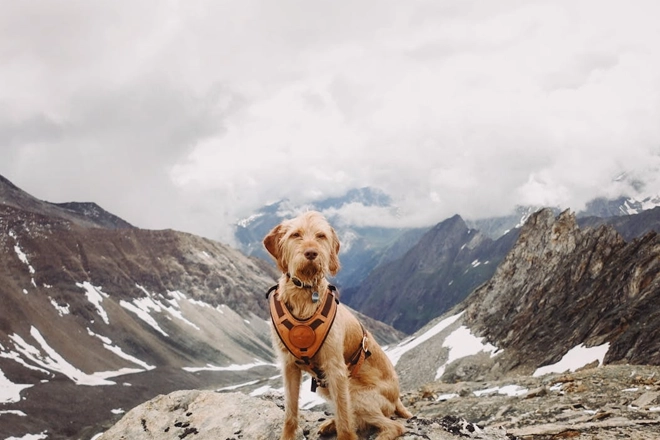For the Purrbabies


How to train, prepare, and gear up for a safe and fun hiking adventure with your dog.

Hiking with your dog is a great way to explore the outdoors and get exercise together, but it’s not something you should do without ample preparation. From training to gear to trail rules, here are the essentials to make your adventure safe and fun for both you and your pup.
Training is essential on the trail. Hiking environments can be unpredictable, so it’s important your dog responds to voice commands, especially when encountering people, wildlife, or other distractions.
Recall training is essential no matter what, but especially if your dog will be off leash. Hiking trails are full of wildlife, unfamiliar people, and new smells meaning your dog needs to come when called, every time. A strong recall can be life-saving if your pup chases something or wanders toward danger. Start in quiet areas, like your home or an empty dog park, and build up to more challenging environments. You should feel confident your dog will return to you no matter the situation and if you don’t, perhaps your dog isn’t ready to hit the trail.
Even if some trails allow off-leash dogs, many don’t. And when the trail gets busy, narrow, or a little dangerous, a well-behaved dog on leash makes a big difference. Leash train with short, consistent sessions and reward calm walking at your side.
Some dogs get overwhelmed by new environments. Desensitization can help your dog feel more comfortable with things like running water, rustling branches, or passing hikers. Start by introducing these sights and sounds in low-pressure situations. From there, you should build on that gradual exposure to grow your dog’s confidence and help prevent anxiety-related behaviors on the trail.
Unfortunately, we can’t outtrain situations out of our control, which can happen when out hiking in the elements. But doing your due diligence not only makes your dog a better hiking companion, but a better, safer pet wherever you two may adventure be it the mountains or the beach.
Not all trails are dog-friendly—and even those that are may not suit your dog’s fitness or comfort level. Before you head out, make sure you have all the information necessary to make an informed, safe decision for you and your dog. That includes checking in on:
Some trails are pet free, meaning that even your incredibly well behaved adventure dog isn’t welcome. Check the park or trail website before you go or call the local park ranger. Ignoring the rules could lead to fines or create safety issues for other hikers and wildlife.
Know that a three-mile hike on flat ground is very different from a three-mile climb over rocky switchbacks. Consider your dog’s age, breed, and fitness level when determining which trails to hike on and how long to be out. Senior dogs, brachycephalic breeds, and puppies will need shorter, less intense routes.
Rain and snow can turn some trails into slippery messes, and extreme heat or cold can make hiking dangerous no matter what. Also, check for trail closures, downed trees, or flooded areas that might impact your route. Trail review sites or park alerts are a great place to start.
👉Chat with your vet about whether your dog is a right fit health wise to be doing such intense exercise.
This is especially important since there is an inherent risk to taking your pup on an outdoor adventure. Weather can change incredibly quickly, sometimes so fast that you’re unable to find shelter until it passes. Due to this, you should always be researching the weather ahead of time, but so too should you be keeping an eye on the sky throughout your hike. If you notice any of these while hiking, return to your car, cabin, or seek shelter immediately:
👉You should also be aware of how your dog handles regular seasonal weather such as cold winter days or the hot summer sun.
Different regions pose different risks. Ask your vet if your dog needs vaccines beyond the basics, like:
👉Discuss where you’re going with your vet who can help advise on what other vaccinations your dog may need.
"When traveling, there may be a higher probability of disease or exposure to illnesses in certain places. Owners may choose to get additional vaccines for their pets to 'cover' for a particular disease in case of exposure, such as a Lyme disease vaccine when visiting the Northeastern, mid-Atlantic, and upper Midwestern regions of the United States." - Dr. Bruce Armstrong, DVM
The right supplies can make all the difference in whether you and your pup have a great day in the great outdoors or not. Here’s what to bring to keep your dog safe, comfortable, and happy on the trail:
Whether a short stroll or a multi-day hike, these are the handful of things you need to have:
Respecting trail rules and other hikers makes the experience better for everyone. While each trail and national park may have their own rules, there are some general ones that apply no matter where you go.
If your dog is anxious around strangers or other dogs, consider hiking during less busy hours. If you encounter another reactive dog, calmly move away without tension on the leash.
Hiking can strengthen the bond between you and your dog, provide mental stimulation, and give your pup a serious energy outlet. With preparation and the right mindset, it’s one of the best ways to enjoy the outdoors together.
Start with short hikes and gradually increase distance. Most dogs do well with 1-3 hour hikes, depending on their fitness and breed. Regardless of your pet’s fitness, pay attention to any signs of symptoms of distress.
If your dog is healthy, trained, and you plan appropriately, hiking can be great enrichment and exercise.
Active breeds like Labrador Retrievers, Border Collies, and Australian Shepherds typically love hiking. But any healthy, motivated dog can enjoy it.
Offer water every 15-30 minutes, especially in warm weather. Watch for signs of overheating like excessive panting or lagging.








